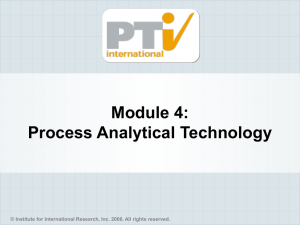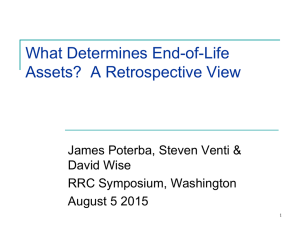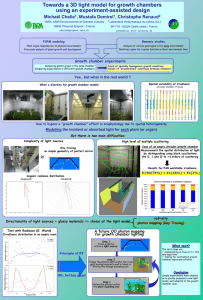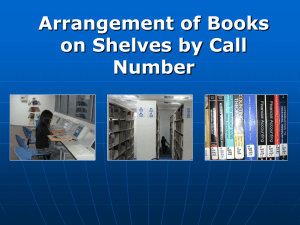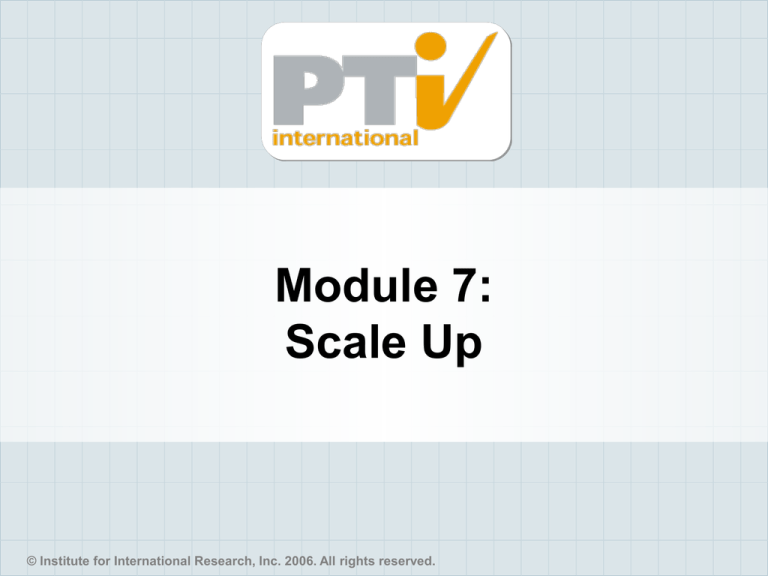
Module 7:
Scale Up
© Institute for International Research, Inc. 2006. All rights reserved.
Module 7 Purpose and Objectives
Module Purpose:
Scale Up includes technical transfer. Putting a
product into a different lyophilizer has
considerations.
Module Objectives:
After this module, you will be able to
Know the questions to answer during the tech
transfer of a product to a different lyophilizer.
2
international
Tech Transfer Overview
I. Describe the Process
II. Essential Qualification Data for Lyo
Comparisons
III. When to change your Lyo vs. When
to change my process.
IV. Performance Qualification – What
does the Science say is needed?
3
international
I. Describe the Process Cycle
Each of the items listed here impact a lyophilized
product tech transfer.
Product Physical Chemistry
Lyo Process Steps
Mechanics
Control
Reporting
Clean Up
4
international
Physical Chemistry: What Matters?
• Collapse
Temperature
• Crystalline materials – e.g. Mannitol
• Re-adsorption of water - Stoppers
• Component Changes
• Glass interactions
• Stopper formula issues
5
Physical Chemistry
international
Collapse
Collapse refers to melting of mostly non-ice portions of
a frozen matrix.
Freezing is a ‘water purification step’. Water molecules
line up with one another and exclude non-water
molecules.
6
Physical Chemistry
international
Recognize Collapse
Correct
7
Physical Chemistry
Shrinkage
Meltback
international
How to Measure Collapse Temperature
Freeze Stage Microscopy
Glass Transition Temp. Tg
Tg is a function of moisture content at the time
of measurement. In that context, it is referred
to as Tg’.
8
Physical Chemistry
international
Freeze Drying Microscopy
9
Physical Chemistry
international
Differential Scanning Calorimetry
10
Physical Chemistry
international
Tg’ and Tc Examples
Collapse Temp
Tg’
Fructose
Glucose
Maltose
Sorbitol
-48
-40
-32
<-45
-42
-43
-30
-44
Sucrose
Bovine Serum
Albumin
-32
-4
-32
-5
Dextran
PVP
Lactose
-9
-17
-32
Compound
11
Physical Chemistry
international
Degree of Crystallinity
Possible to estimate by DSC
Critical to reproducing sublimation results
Virtually never done due to the difficulty of
reproducing the freezing conditions.
12
Physical Chemistry
international
Re-adsorption of Water
Assure that stopper sterilization results in a dry stopper, or else dry it in a
sterile oven.
Check 6 month stability data for moisture content.
Stopper Wt = 2.179 gm
3% Moisture = .03 x 2.179 = 65.4mg H2O
Product = 3mL at 5% solids
.05 x 3mL = 150 mg Product after Lyo
Moisture Spec = <2%
.02 x 150mg = 3 mg H2O max
13
Physical Chemistry
international
Transition
Physical
Chemistry
Process
14
international
Freezing
• Large ice crystals will reduce sublimation time.
• Crystallization of excipients such as mannitol may occur and can
be controlled separately from water ice.
• Supercooling is when the liquid water temperature is below the
freezing temperature of the solution. Freezing is an exothermic
event. The latent heat given up is measured as an increase in
probe temperature.
• Factors that effect supercooling include
•Chilling rate
•Container shape and volume
•Holding time
•Solution particulate content
•Temperature
Steps: Freezing
15
international
Enthalpy Change on Freezing
Enthalpy (symbolized H, also called heat content) is the sum of the internal energy of matter and the
product of its volume multiplied by the pressure. Enthalpy is a quantifiable state function, and the total
enthalpy of a system cannot be measured directly; the enthalpy change of a system is measured
instead. Enthalpy can only be applied to a body at constant pressure.
H = U + PV
16
Lyo Process Steps: Freezing
Enthalpy is most useful when
pressure is held constant through
exposure to the surroundings, to
analyze reactions that increase the
volume of the system, causing it to
do mechanical work on the
surroundings and lose energy.
For an exothermic reaction at
constant pressure, the system's
change in enthalpy is equal to the
energy released in the reaction,
including the energy retained in the
system and that lost through
expansion against the surroundings.
international
Annealing
Annealing is a treatment of the frozen matrix that involves
raising the temperature of the ice to just below the melting
point of water. For example: -7 degrees C. The
temperature is then held for some reasonable time and
water molecules that are in smaller crystals will dissolve
and refreeze onto larger crystals. The larger crystals lead
to a larger porosity and faster sublimation.
17
Lyo Process Steps: Freezing
international
Validate an Extended Freeze
Can you freeze for too Long?
No. If you need to extend a cycle during
freezing it is scientifically OK to do so.
During validation, it may be useful to show
that the same result is achieved with the
standard freeze time and with a freeze time
that is extended for 24 hours. That should
be more than enough time to
accommodate emergencies.
Yes. If the product is known to be unstable
in the frozen state.
18
Lyo Process Steps: Freezing
international
Sublimation
Stay below the collapse
temperature and then time is of no
consequence to science.
19
Lyo Process Steps: Sublimation
international
Measure the Sublimation Rate
Keep it Simple
Rate
gm
cm 2 hr
• Grams refers to total grams of product solution put into the lyo.
• cm2 refers to the total surface area calculated from the vial dimensions.
• Hours refer to the total time between points A and B.
Picking Point B can be
a little arbitrary so try
to be consistent.
20
Compare Rate
data between
the 2
Lyophilizers
international
Tray Size
Vials near the tray rings dry faster than vials not near to the ring. If the trays
are larger or smaller, then one can expect the drying rate to be different.
If the new
chamber is not
the same size
as the original
one, then it is
quite likely
that the trays
may not be the
same size
either.
21
Lyo Process Steps: Sublimation
international
Changes in RATE
Other Reasons why Sublimation Rate might
Change when one changes Lyophilizers
If the spacing between the shelves is different then you
can expect the rates might change.
If the serpentine fluid flow path is different inside the
shelves, then heat transfer may be different.
If the thickness of the shelves is different, then there may
be a thermal delay or acceleration.
22
Lyo Process Steps: Sublimation
international
Vacuum
If the vacuum can’t be held at exactly the same level,
then major differences in rate may be observed.
• Vacuum plays a major role in determining the
temperature of the ice.
T (°C)
Temperature is determined
from pressure exactly as
shown in the table.
Except: Pressure at the ice
surface is always higher than
pressure measured in the
chamber.
23
Lyo Process Steps: Sublimation
0
-5
-10
-15
-20
-25
-30
-40
-50
-60
-70
-80
-90
P (Torr)
P( mbar)
4.57900
6.105
3.01300
4.017
1.95000
2.600
1.24100
1.655
0.77600
1.035
0.47600
0.635
0.28590
0.381
0.09660
0.129
0.02955
0.039
0.00808
0.011
0.00194
0.003
0.00040
0.001
0.00007
0.000
P (Pa)
610.483
401.700
259.979
165.453
103.458
63.461
38.117
12.879
3.940
1.077
0.259
0.053
0.009
international
Secondary Drying / Desorption
• Sublimation has ended when the phase
change is complete. i.e. all of the ice
crystals have sublimed.
• Usually, less than 15% water by weight is
still present. Often, less than 2% water by
weight will be present.
• The goal of secondary drying is to drive
away the remaining moisture by desorption.
24
Lyo Process Steps: Desorption
international
Langmuir Model for Adsorption
G+S
25
Lyo Process Steps: Desorption
GS
international
Moisture Saturation at Equilibrium
26
Lyo Process Steps: Desorption
international
Absorption
Different starting points may yield different
final moisture levels.
Best to use a measured end point such as
pressure rise.
27
Lyo Process Steps: Desorption
international
Transition
Process
Mechanics
28
international
Mechanics (Physical Comparison)
29
Condenser Capacity and Load
Ice surface area to Condenser capacity ratio
Isolation Valve Size and Design
Chamber Size
Vacuum Effective Pumping Speed
Refrigeration
Mechanics
international
Can the Chamber be too Big?
Run 4 Loads in the same lyophilizer.
Load 1 = Single Vial
Load 2 = Quarter Full
Load 3 = Half Full
Load 4 = Full
These four loads will lyophilize at four different rates.
{What might this mean to validation?}
30
Mechanics - Condenser
international
Condenser Capacity
One way to compare two lyo’s is to determine the ratio of
condenser capacity to total shelf area (should be vial surface
area). If the numbers for different lyo’s are similar then one
might argue that the cycle rates will be similar.
Sq. Ft
Condenser
Capacity
Trays
Condenser
Capacity/Tray
Lyo 1
24
40L
12
3.3
Lyo 2
250
200L
120
1.7
Clearly the smaller Lyo has twice the “power” of the larger one, and
consequently, the cycle used in the smaller lyo may have to be adjusted to
work the same in the larger unit.
31
Mechanics - Condenser
international
Isolation Valve
All of the ice in the Chamber must squeeze through this opening to get into the
condenser. Therefore it is possible to make the size of the valve rate limiting.
When that occurs, it is called “Choked Flow”. In that instance, the chamber will
not maintain pressure and its pressure will exceed that of the condenser.
32
Mechanics - Valve
international
External Leaks
Lyophilizers leak in air from somewhere and the leak
holes are larger than the size of bacteria.
Parenteral Society specifies a leak rate of (0.02 mBar-L /
sec) for a new clean empty freeze dryer.
Real rates for older equipment are closer to 0.56 mbarL/sec
Literature reports go as high as 1mBar-L/s
Admit that Lyophilizers Leak. Be sure that the
production model leaks are inconsequential.
33
Mechanics – Leak Rate
international
External Leaks
Leak Rate
Single Source &
Round.
Diameter =
Number of
0.2µm diameter
pores
0.000004 mbar-L/s
0.208µm
1
0.02 mbar-L / s
14.7µm
5,387
0.56 mbar-L / s
77.7µm
150,823
1 mbar-L / s
104µm
269,327
Calculation available at www.SublimationScience.com
34
Mechanics – Leak Rate
international
Heat Exchange
Lexsol or Silicone Oil
35
Mechanics – Exchange Fluid
international
Transition
Mechanics
Control
36
international
Control
•
•
•
•
•
Product thermocouples
Capacitance manometers – chamber & condenser
Temperature – vials, drain, shelf I/O, condenser I/O
Thermal feedback to regulate shelf heat?
Pressure feedback to reduce shelf heat in the event
of too much differential between chamber and
condenser.
• PLC’s for operational control (UPS backup)
• HMI (Computer) for data collection (UPS backup)
• SCADA for independent simultaneous data
collection.
37
Control
international
Transition
Control
Reporting
38
international
Reporting
Require Human Analysis.
Provide a standard to check against.
Assure that data backup occurred.
39
Reporting
international
Transition
Reporting
Cleanup
40
international
Clean Up
CIP & Testing
• Visually Confirmed as
Clean (no glass or
rubber).
• TOC Swabs
• Log maintained with
entries for every event.
• Compressor and pump
oils full and clean
• Lyo Area is Tidy.
Sterilization
• Validated & Audited
• Current Instrument
calibrations
• Filter integrity test
performed pre and post
sterilization.
41
international
Essential Qualification Data for Lyo Comparisons
42
What test data are required and why?
How to use the OQ data?
Shape matters
Stopper placement is an issue
Maps – why do we care?
II. Lyo comparison
international
Data Use
Physical Data – External/Internal condenser. If external,
over, under, side-by? Stoppering from above or below?
Physical Data – chamber & condenser size, shelf size,
distance between shelves, tray & vial size and number,
fill volume, isolation valve size.
Physical Data – vacuum scfm and blank off pressure,
foreline lengths, leak rates for chamber/condenser,
pump down time from atmospheric.
Physical Data – heating / cooling rates. Compressor
horsepower, heat exchanger size, exchange fluid type.
Location of TC’s for shelf I/O and condenser
temperature.
Location of Pressure probes.
43
II. Lyo comparison
international
Data Use
OQ:
Shelf flatness !! Critical to stoppering. Ideal is
shelves flat to within + 0.05 mm. Even this spec may
be 5x to small.
The majority of workshops have straight edges
ranging from steel rules to precision knife edges
generally up to 4 ft long. Using these, departures from
flatness of a surface of the order of .025mm can be
readily observed against an illuminated background.
For example, the Starrett company makes these in
useful lengths.
44
II. Lyo comparison
international
Data Use
OQ: Ability of the system to do the deed.
Availability of cooling ramp and heating ramp.
Max cool down rate of the empty chamber
Max cool down rate of a simulant full chamber
Max shelf heating rate
Minimum condenser temperature
Minimum system pressure
Time to attain minimum pressure of an empty dry chamber
Set point tolerances for temperature and pressure
Minimum shelf temperature
Maximum shelf temperature
Pressure data availability for all relevant ranges.
Stopper placement of identical vials and stoppers holding
simulant
Choked Flow Test
45
II. Lyo comparison
international
Shape Matters
46
Tray Size
Chamber Size vs. Condenser Size
Chamber Size vs. Isolation Valve Diameter
Foreline length
II. Lyo comparison
international
Stopper Placement is an Issue
Do not assume it will go smoothly.
Check it out.
47
II. Lyo comparison
international
Maps – who cares
Sterility of the empty chamber should be mapped for
uniformity. All spots must be shown to experience sterilizing
conditions.
Shelf temperatures should be known! But + 2 degrees C is
acceptable. Temperature of the ice and consequently
catastrophic collapse is controlled by pressure. Heat input,
which is quite diffuse is controlled by shelf temperature. At
worst, (and unavoidable in all cases) if the shelf temperature
is less uniform, then a section of the vials will dry faster than
another section. Duh!
Already, due to the presence of tray rings, chamber edges,
and sight glasses, some of the vials dry much faster than
others. A small temperature difference in shelf uniformity is of
small consequence.
Suggestion: Set the shelf uniformity spec to 1.5 or 2 times the
manufacture’s specification.
48
II. Lyo comparison
international
Max Sublimation Rate (‘Choked Flow’)
Load all shelves and tray positions of the lyo with tray
rings containing plastic film to hold water.
Transfer a weighed amount of water to each tray ring
such that each is about 1” deep.
Freeze to a steady state of -40 C.
Monitor chamber and condenser pressure
Initiate vacuum to the lowest normally achievable set
point (e.g. 80 mtorr) and stabilize the pressure.
Ramp temperature at 0.33 C/min
49
international
Max Sublimation Rate (‘Choked Flow’)
Continue the Shelf Temp Ramp to the maximum shelf
temp for the heaters.
At some shelf temperature, the chamber pressure may
exceed its set point (80mtorr). At that same temp, the
condenser pressure may continue to hold set point. If
so, that is evidence for a sublimation limit for that lyo
limited by the isolation valve diameter.
Stop the run, reweigh the ice in a tared plastic bag and
calculate a crude sublimation rate in gm/cm2∙hr.
50
international
Max Sublimation Rate (‘Choked Flow’)
Repeat the run to the point of stabilizing pressure at 80
mtorr.
Ramp the shelf temp ASAP to 2 C below the
temperature where the chamber can’t maintain set point.
Hold shelf temp long enough to sublime ~15% of the
water. (Use the rate calculated above to determine how
long that is)
End the run and reweigh the ice.
Calculate the “maximum supportable sublimation rate”
excluding the ramp time in gm/(cm2∙hr).
51
international
III. When and What to Change
52
Sterilization
Instrumentation
Vacuum
Refrigeration
Control
III. Change
international
Sterilization
No compromises. All data for the empty chamber
and media fills must be perfect.
Filter integrity testing must exist between every run.
53
III. Change
international
Instrumentation
Chamber and condenser pressure are mandatory.
You can’t do a Choked Flow Test without them.
Product Temperature measurement – doesn’t have to be
direct, e.g. MTM.
Some people just don’t get it.
Drain temperature for sterilization.
All else can be compromised. More is better.
54
III. Change
international
Vacuum
Vacuum must be adequate to run the cycle.
Backup vacuum capacity (2 pumps whenever 1 is
sufficient to maintain) may save a lot.
Pump down times and ultimate vacuum (leaks
happen) may be drastically improved by shortening
and increasing inner diameter of the foreline.
55
III. Change
international
Refrigeration
According to one lyo repair firm, 40% of lyo mechanical
issues trace back to faulty refrigeration. Don’t
compromise on refrigeration maintenance.
Refrigeration capacity will be sufficient, or else the
machine will not run the cycle.
Look at the loaded condition maximum cooling rate OQ test.
Check especially that the compressors can maintain the coldest
loaded shelf temperature with the condensers completely cold.
Many older units can’t do this.
A currently popular cycle step is to initiate vacuum and then hold
the frozen shelf temp. (e.g. -50C) for 30 minutes prior to initiating
the 1st ramp. Since the condenser must now be turned on,
compressors are challenged.
56
III. Change
international
Controls
Lack of a cooling ramp may be adequately overcome by
stair steps.
Feedback control to the shelf heaters from either product
TC’s or chamber pressure is unusual for cycles but
common for lyophilizers. Regulated cycles that use
feedback control are rare because the cycle length
changes (for good reason) noticeably with normal
variation to a single lot size.
PLC’s, HMI’s and SCADA backup are virtually required.
57
III. Change
international
PQ & Technology Transfer
58
Sterility
Final Moisture, Activity & Stability
Reconstitution
Appearance
Lot Size
Number of Runs
Simulants
IV. PQ
international
Sterility
Empty chamber 3x
Media fills in a similar vial.
59
IV. PQ
international
Moisture/Activity/Stability
Measure Moisture and Drug activity immediately and put
on to accelerated stability – not less than 6 months.
Moisture cannot be lyophilized out of a stopper. But it
comes out over the 1st 6 months. And it goes into the
product.
Best done with a full load of the real drug.
2nd best, done with a simulant to keep the number of
vials the same as a full load.
60
IV. PQ
international
Reconstitution
Poor reconstitution is caused by
Partial collapse / shrinkage
Low surface area due to increased crystallization
during freezing or just a different ice structure. –
changing the freezing conditions often causes
problems.
61
IV. PQ
international
Appearance
Change the conditions and you change the appearance.
– Be Prepared (for a shock).
It will probably be necessary to change the cycle in a
new lyophilizer in order to reproduce the appearance
from some other lyophilizer.
62
IV. PQ
international
Lot Size
Run a minimum lot size just to show you can, but
validate (3x or 5x) at the full lot size.
Sublimation times are ice volume dependent. You must
use a full load to assure that you can do a full load.
63
IV. PQ
international
Number of Runs
Stress testing or trying to validate a range for
temperature and pressure is “nice” but usually not
practical. Furthermore, any deviations in pressure and
temperature are not likely to stay within the validated
range. When operating correctly, temperature will hold
to within + 2 degrees and pressure should be controlled
to within + 10 mTorr. When these parameters stray,
they don’t usually stay close!
Time deviations should be scientifically justified (such as
nearly unlimited time at -50 C) and then validated to
some reasonably long interval.
64
IV. PQ
international
Simulant
Product simulants can be used to bulk up a validation
load and thereby conserve expensive product.
Simulants can possess most of the properties of the
lyophilized cake including especially appearance.
Appearance is an important simulant property because it
assures that the ice structure and thus the sublimation
time is somewhat similar to the product.
FDA has always required at least one full load without
simulant.
65
IV. PQ
international
7.1 Exercise
Outline a Tech Transfer Plan
Current Process Description
Equipment Comparison at contract vendors
Existing OQ Data Desired
New Validations OQ/PQ
66
international
Product Description
Product is a peptide – no sulfhydrals: fill vol = 1mL
Collapse Temp is ~ -15 C
Protective agent: Albumin, 2%, also adds bulk.
Surfactant: Polysorbate 80, aids dissolution
Citrate Sodium for tonicity and pH.
pH: 5.2, aqueous
Activity decreases ~0.5% every 12 hours post
compounding. Decrease is assumed linear during the 1st
12 hours.
67
international
Original Lyo Description
Chamber size: 200 ft2
10 shelves, 5 ft wide x 4 ft deep
Used 4’x4’ of each shelf with 8 each, 1 x 2 trays.
Vial dia = 17mm, 660 vials per tray
Full load = 660mL x 80 trays = 52,800 1cc units
Intershelf spacing = 4”
External condenser capacity: 250 liters
Isolation Valve = 7” ID with butterfly motion internal.
Two Vacuum pumps in parallel each rated for 200 scfm
with about 20 ft of 4” pipe leading to chamber and
condenser inlets.
68
international
Planned Lyo after Transfer
Chamber size: 360 ft2
12 shelves, 5 ft wide x 6 ft deep
Use all of each shelf with 15 each, 1’ x 2’ trays.
Vial dia = 17mm, 660 vials per tray
Full load = 660mL x 180 trays = 118,800 1cc units
Intershelf spacing = 2.5” (vial height 1.49”)
External condenser capacity: 600 liters
Isolation Valve = 12” ID with butterfly motion internal.
Two Vacuum pumps in parallel each rated for 300 scfm
with about 20 ft of 4” pipe leading to chamber and
condenser inlets.
69
international
Original Cycle
70
international

